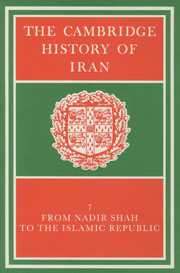Book contents
- Frontmatter
- PART 1 THE POLITICAL FRAMEWORK, 1722–1979
- PART 2 FOREIGN RELATIONS
- PART 3 ECONOMIC AND SOCIAL DEVELOPMENTS
- PART 4 RELIGIOUS AND CULTURAL LIFE, 1721–1979
- 19 RELIGIOUS FORCES IN EIGHTEENTH- AND NINETEENTH-CENTURY IRAN
- 20 RELIGIOUS FORCES IN TWENTIETH-CENTURY IRAN
- 21 POPULAR ENTERTAINMENT, MEDIA AND SOCIAL CHANGE IN TWENTIETH-CENTURY IRAN
- 22 PRINTING, THE PRESS AND LITERATURE IN MODERN IRAN
- 23 PERSIAN PAINTING UNDER THE ZAND AND QĀJĀR DYNASTIES
- 24 THE ARTS OF THE EIGHTEENTH TO TWENTIETH CENTURIES
- Genealogical tables
- Bibliographies
- Index
- References
21 - POPULAR ENTERTAINMENT, MEDIA AND SOCIAL CHANGE IN TWENTIETH-CENTURY IRAN
from PART 4 - RELIGIOUS AND CULTURAL LIFE, 1721–1979
Published online by Cambridge University Press: 28 March 2008
- Frontmatter
- PART 1 THE POLITICAL FRAMEWORK, 1722–1979
- PART 2 FOREIGN RELATIONS
- PART 3 ECONOMIC AND SOCIAL DEVELOPMENTS
- PART 4 RELIGIOUS AND CULTURAL LIFE, 1721–1979
- 19 RELIGIOUS FORCES IN EIGHTEENTH- AND NINETEENTH-CENTURY IRAN
- 20 RELIGIOUS FORCES IN TWENTIETH-CENTURY IRAN
- 21 POPULAR ENTERTAINMENT, MEDIA AND SOCIAL CHANGE IN TWENTIETH-CENTURY IRAN
- 22 PRINTING, THE PRESS AND LITERATURE IN MODERN IRAN
- 23 PERSIAN PAINTING UNDER THE ZAND AND QĀJĀR DYNASTIES
- 24 THE ARTS OF THE EIGHTEENTH TO TWENTIETH CENTURIES
- Genealogical tables
- Bibliographies
- Index
- References
Summary
The 20th century has witnessed a dramatic change in the kind and form of entertainment in Iran. This is particularly true of the period since World War II. Some traditional entertainments have disappeared, others have undergone radical transformation, some are dying. New foreign forms have appeared and become popular. The crucial point, however, is that for the majority of the population, especially those living in towns, their major entertainment is no longer connected with the seasonal festivals such as the spring solstice and the autumn harvest, nor with religious holidays. Entertainment has become more a leisure pastime unrelated to calendar determinants. These changes result from rapid urbanization, increased means of communication, and the overall shifts in the socio-economic and political structure.
Festivals from pre-Islamic times and connected with the seasons, like Barnishastan-i Kūsa (the ride of the beardless man), which used to take place on a cold day at the beginning of spring, had already died out by the opening of the century, as had Mīr-i Naurūzī (the Prince of the New Year). ‘Umarkushān, a farce played out in town streets from the 16th century onwards, is now forgotten. Khaima-yi Shab-bāzī, the puppet theatre, with glove-dolls and marionettes, is on the wane, although this tradition has been adapted and used by some contemporary playwrights. Tamāshā: acrobats and conjurers, snake charmers, monkey tamers, and Lūtīs who performed in the public squares and coffee houses are only now rarely seen. Pardadārī is story-chanting with the aid of a huge illustrative painting on a canvas usually measuring 3 × 1½ metres, and held up between poles at both ends.
- Type
- Chapter
- Information
- The Cambridge History of Iran , pp. 765 - 814Publisher: Cambridge University PressPrint publication year: 1991
References
- 3
- Cited by

